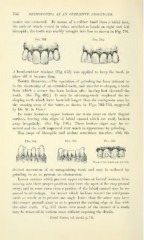Page 738 - My FlipBook
P. 738
736 ORTHODONTIA AS AN OPERATIVE PROCEDURE.
canine was extracted. By means of a rubber band from a labial bow,
the ends of which rested in tubes attached to bands on right and left
bicuspids, the tooth was readily brought into line as shown in Fig. 701.
Fio. 702. Fig. 703.
A band-and-bar retainer (Fig. 653) was a])plied to keep the tooth in
place till it became firm.
Tooth Shaping.—The operation of grinding has been referred to
in the shortening of an extruded tooth, and also for re-shaping a tooth
from which a corner has been broken after having first elevated the
tooth. (See Fig. 692.) It may be advantageously employed for re-
shaping teeth which have been left longer than the contiguous ones by
the wearing away of the latter, as shown in Figs. 702-705, suggested
by Dr. W. S. How.'
In many instances upper incisors are worn away on their lingual
surfaces, leaving thin edges of labial enamel which are easily broken
away irregularly. (See Fig. 706.) These broken edges may be re-
moved and the teeth improved very much in appearance by grinding.
The cusps of bicuspids and molars sometimes interfere with the
Fig. 704. Fig. 705. Fig. 706.
Worn or broken teeth (Farrar).
desired movement of an antagonizing tooth and may be reduced by
grinding so as to present no obstruction.
Lower canines which prevent upper canines or lateral incisors from
moving into their proper position may have the apex of the cusp ground
away, and in some cases even a portion of the labial enamel may be re-
moved to advantage. An incisor which inclines toward the contiguous
tooth so much as to present one angle lower than the other may have
this corner ground away so as to present the cutting edge in line with
the other teeth. Fig. 707 shows how much of the enamel of a tooth
may be removed in various cases without exposing the dentin.
^ Dental Cosinos, vol. xxviii. p. 741.


